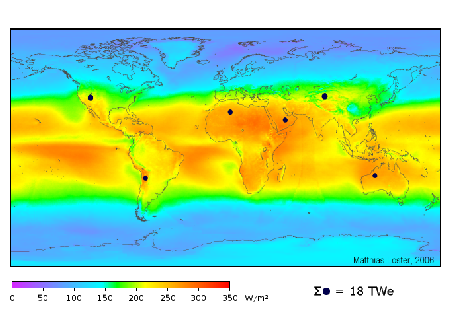
A map of solar energy hitting the Earth's surface. Near the equator it is strongest (red), falling off rapidly as you near the poles to nearly nothing (purple).
The Sun generates a huge amount of energy, which reaches us as both heat and light.[1] Directly or indirectly it powers almost all life on Earth.[2]
Enough light from the Sun hits Earth every hour to power all of humankind for a year.[3] Despite this it has been hard to harness this energy directly in a way that can scale up easily and cheaply. In the next few slides we examine a few of the available technologies that use solar energy to generate power.
The Sun is a giant nuclear reactor, fusing hydrogen into helium and thereby releasing huge amounts of energy (this is the same process unleashed in a thermonuclear bomb). For details of the nuclear reactions which take place in our Sun and all other stars see Wikipedia: Stellar nucleosynthesis.
Plants use light for photosynthesis to make food for themselves and the animals which feed on them. For heat and electricity we burn wood along with the fossilised remains of prehistoric plants in oil, gas and coal. Even wind power comes from changes in the atmosphere driven by the Sun.
The exception is some deep-sea and underground bacteria, which survive from chemical energy alone, and the organisms which feed on them.
This figure comes from Wikipedia: solar energy. The total solar energy absorbed by Earth's atmosphere, oceans and land masses is approximately 3,850,000 exajoules (EJ) per year. In 2002, this was more energy in one hour than the world used in one year.
Author: Tom Brown
Copyright: public domain
Date last modified: 13th Oct 2011
Peer-review status: Not yet peer-reviewed
Solar land area: source: Wikipedia, copyright: CC